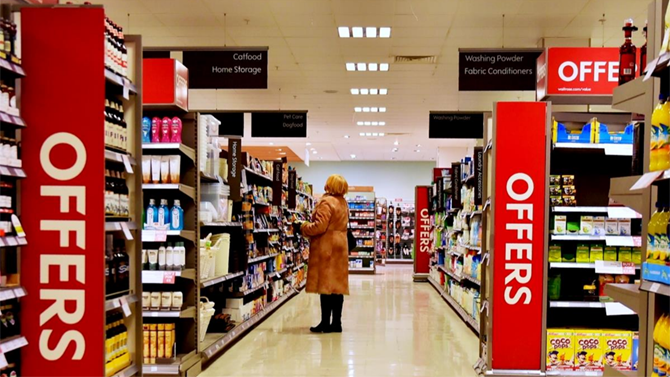Investigation into the balance of healthy versus less-healthy food promotions

- Project start date: 1 January 2016
- Project status: Completed
- Project type: Nutrition
- Discipline: Food marketing
- Author/s: Dr Sinead Furey, the University of Ulster
- Collaborator/s: Dr Moira Dean, QUB, Prof Monique Raats, University of Surrey, Dr Celine Murrin, UCD, Dr Mary McCarthy, UCC, Dr Ruth Price, NI Centre for Food and Health, UU
Research objective
- To independently audit the type and nutritional quality of food and drink on promotional offer in retail outlets in Ireland
- To understand the perceptions of food retailers relating to promotional offers and their influence on consumers’ purchasing behaviour in the context of the Irish food retail environment
- To investigate the different factors influencing the retailers’ commitment to promoting certain foods using promotions
- To understand consumers’ perceptions and motivations to select and purchase, as affected by promotional activity
- To propose recommendations for creating a healthy shopping environment to increase consumer accessibility, affordability and acceptability to healthier food products sold on promotion
Outputs
Research report
- Title: What's on offer?
- Publication date: 15 January 2019
- Summary: With two in three Irish adults overweight or obese, one in six living in poverty, and the majority spending their money more carefully now than in the past, there is an urgent need to understand the availability of healthy food promotions to help householders manage food budgets.
- Findings:
In-store audit
- 35% of the total sample of food and drinks audited were categorised as high in fat, sugar and salt, a clear over-representation of their distribution in the food pyramid.
- 56.1% of foods on promotion in convenience stores were high in fat, sugar and salt.
- The nutritional quality score was based on the energy, fat, saturated fat, sugar and salt levels of each food product, rated as high, medium or low nutritional quality. Using this measure, almost equal proportions of foods classified as having a low (27.8%) or medium (27.3%) quality score while 45% of the foods audited had a high nutritional quality score.
- Most promotions were price-based i.e. reduced price or volume-based.
Online audit
- There was an over-representation of foods high in fat, sugar and salt on promotion, particularly during the winter season.
Stakeholder interviews
- Interviews with retailers and public health stakeholders about retail food promotions identified three main themes: importance of health in promotional strategies, profit before health and policy engenders action. Retailers variously cited health and customer value as central to their promotional strategies. There was also recognition that future policymaking requires retailers to ensure that retail settings are health-focused.
Consumer survey
- The survey explored consumer perceptions and behaviours of foods sold on promotion.
- 91.6% of consumers regularly bought food on promotion and showed a preference for “price reductions that offer a cost saving” and volume-based types of promotions.
- Consumers were classified from the survey based promotional preferences as promotional health rounded; promotional deal prone; or promotional 5-a-dayer.
- Shoppers were also classed based on what food and drink that they purchase on promotional offer: daily staples purchasers; 5-a-day purchasers; and deal prone purchasers.
- It was clear that consumers’ motivations for buying food on promotion is variable as consumers engage differently with promotional food items due to various factors.
Accompanied shop
- Identified primarily positive attitudes towards food retail promotions due to their contribution to cost savings, particularly on branded products.
- All shoppers displayed a level of awareness regarding the availability of promotions on offer, however the way in which they choose to respond to them differed with six clear consumer behaviours relating to: bargains that benefit the household budget, the buzz of a bargain, savvy stockpiling, active avoidance of available offers, reliance on regular reductions, and using deals to dictate dinner.
- Recommendations:
- Encourage retailers to use the food pyramid in retail planning as a means of assessing the proportions of healthy and unhealthy foods on promotional offer.
- Encourage retailers to promote food and drink in line with the balance of the food pyramid such as reducing the promotion of food and drinks high in fat, sugar and salt.
- Use research data and insights to target healthier food promotions to different consumer sub-groups.
- Monitor the types of food and drinks on price promotion.
- Promote consumer awareness on how healthy foods on price promotion can be used in meal planning.
- Promote consumer awareness of strategies that can be used to shop in a way that supports healthy eating guidelines.
You can download the report below.
Similar research
- Exploring the world of food - the perspective of families with children (2019)
- What's on offer? Food for our kids in social spaces (2018)
- Do nutrient and health claims have an impact on the perceived healthiness and the amount of foods/meals consumed? (2016)
- Good days and bad days - habits of shoppers when they do or don't buy healthy foods (2013)
- Food Marketing and the preschool child (2011)
- Food Values Pilot Programme Evaluation (2010)
- Good days and bad days: an investigation of the habits of shoppers when they do or don't buy healthy foods (2010)




